Article from Edible Manhattan (2012):
 On any given day at Murray’s Cheese—the 80-year-old shop on Bleecker Street where caseus is king—you’ll see not just tourists off the double-decker bus (geeking out on the sheer size of the wheels of Comté, cheddar and Emmentaler stacked in the glass-walled storage space in the back) but firemen still in their boots, chefs like Tom Colicchio and Anita Lo, celebrities like Whoopi Goldberg and the notoriously crowd-hating comedian Louis C.K. Even he will gladly take a little paper slip showing his number, waiting for a chance to have the ear of one of Murray’s many red-coated mongers flitting about behind the long counter.
On any given day at Murray’s Cheese—the 80-year-old shop on Bleecker Street where caseus is king—you’ll see not just tourists off the double-decker bus (geeking out on the sheer size of the wheels of Comté, cheddar and Emmentaler stacked in the glass-walled storage space in the back) but firemen still in their boots, chefs like Tom Colicchio and Anita Lo, celebrities like Whoopi Goldberg and the notoriously crowd-hating comedian Louis C.K. Even he will gladly take a little paper slip showing his number, waiting for a chance to have the ear of one of Murray’s many red-coated mongers flitting about behind the long counter.
No matter which one of those you score, don’t worry: All are capable of sending an avalanche of adjectives to describe each of the 200 cheeses Murray’s always has on hand, made from milk of goat and buffalo and cow and sheep, sourced everywhere from La Mancha to Modesto. “You want to go more butterscotchy, more caramelly, or more nutty-without-being-so-sweet?” inquires a head-scarfed young monger when asked about aged Goudas, leaning out of the way as colleague in a trucker hat weighs out three tubby squares of Taleggio for a chef in whites.
“It’s going to be nice and rich without being too assertive,” says another, handing over a sample of a Caveman Blue made in Oregon, next to a colleague delivering nutty shards of Sardinian Podda Classico. “You could taste mushrooms,” he suggests, “it could be earthy, bacony, salty: It’s about seasonality, it’s about your body chemistry. It tastes a little different to everyone,” he adds. “It’s not an exact science.”
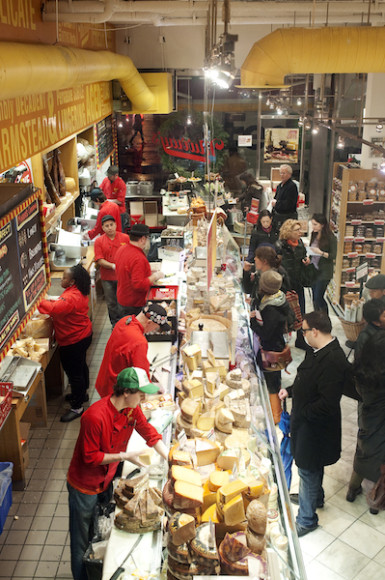 That’s because it’s just cheese—or at least, that’s what the man behind Murray’s, Rob Kaufelt, is fond of saying. Kaufelt’s kind of kidding—Murray’s sells a whopping 800,000 pounds of it a year in New York through its wholesale, retail and online businesses, which is nothing to joke about—but he’s trying to make a point. “It’s about spreading the gospel of cheese,” Kaufelt tells me in the classroom above the selling floor, where half a dozen counter clerks are weighing, slicing, wrapping and rapping. “It’s actually in our mission statement,” he adds, pointing to the wall where it hangs right for me to see in red and yellow: “Bring the best cheese to the largest possible number of people.” In other words, his red-chef-coated staffers might know the exact point at which the fat little rounds of Azeitao are ripe (a raw sheep’s milk cheese from Portugal, it’s practically pudding) or the difference in flavors between Vermont Cheese Company’s creamy little goat cheeses, but he just wants you to eat them instead of shrink-wrapped slabs of supermarket Swiss.
That’s because it’s just cheese—or at least, that’s what the man behind Murray’s, Rob Kaufelt, is fond of saying. Kaufelt’s kind of kidding—Murray’s sells a whopping 800,000 pounds of it a year in New York through its wholesale, retail and online businesses, which is nothing to joke about—but he’s trying to make a point. “It’s about spreading the gospel of cheese,” Kaufelt tells me in the classroom above the selling floor, where half a dozen counter clerks are weighing, slicing, wrapping and rapping. “It’s actually in our mission statement,” he adds, pointing to the wall where it hangs right for me to see in red and yellow: “Bring the best cheese to the largest possible number of people.” In other words, his red-chef-coated staffers might know the exact point at which the fat little rounds of Azeitao are ripe (a raw sheep’s milk cheese from Portugal, it’s practically pudding) or the difference in flavors between Vermont Cheese Company’s creamy little goat cheeses, but he just wants you to eat them instead of shrink-wrapped slabs of supermarket Swiss.
We’d argue that Murray’s Cheese is an institution not because of its longevity—Murray Greenburg opened the original as a 300-square-foot butter and egg shop back in 1940—or its legions of fans, but because of its impact. Since Kaufelt bought the business in 1991 from second owner Louis Tudda—moving what was by then an Italian cheese counter to a slightly bigger spot on the corner of Cornelia and Bleecker—he’s turned the place into a full-fledged dairy emporium, a multifaceted mecca that isn’t just bringing literal tons of great cheese to the masses, but laying the groundwork to make it easier for cheesemakers—and even other store owners—to do it, too.
That influence begins with the recently expanded 1,750-square-foot retail space on Bleecker Street, where Kaufelt moved the store a second time in 2004. With the move he didn’t just double the size of the place, but eventually added dozens of specialty food products, a vast array of charcuterie and an upstairs classroom where hundreds of students sniff and nibble through near daily classes like Mozzarella Making, the Harmony of Beer and Cheese, or the three-day $700 Cheese U Boot Camp, which teaches everything from the origins of cheese (perhaps in an ancient nomad’s swinging leather satchel of camel’s milk, out in some desert) to how to pat down the bloomy rind on the Valencay and Chevrot down in Murray’s basement.
That’s where Kaufelt has installed three underground cheese caves (humidity- and temperature-controlled for bloomy rinds, natural rinds, and washed rind and alpine styles, respectively)—a whiz-bang storage component only a handful of retail shops in the country can claim. Those now store 100 kinds of cheese, and are even able to age rounds from small dairies that lack room to do it themselves. That means Carleton Yoder can send down his dreamy little rounds of triple crème from the Champlain Valley in Vermont to be finished in Greenwich Village, giving him the room to make more cheese. “There are few, if any, other retailers in the country,” says Carleton, “that could do what they are doing with aging.” Which enables Murray’s to sell plenty of cave-aged cheeses, Yoder’s included, beyond their shop: at their outpost in Grand Central Station Market, which opened in 2002, and to 600 restaurant clients in all 50 states, which in Manhattan include Per Se, Blue Hill, Daniel, Eleven Madison Park and Le Bernardin.
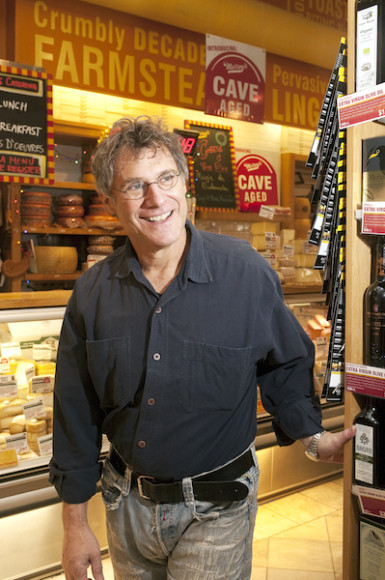 Last but by no means least, the brand supplies 38 and counting “cut and wrap” outposts in Kroger supermarkets around the country, which began opening in cities far, far away from this one in 2009. One was just crowned the best new cheese shop in Cincinnati. All those mini-Murray’s are now fed from a brand-new distribution center in Long Island City, which also supplies Murray’s Catering and Murray’s by Mail. The latter sends out so much of his product in gift boxes and samplers, says Bob McClure, one of the brothers behind McClure’s Pickles, the cheese shop is technically one of the larger distributors of his pickles in the country.
Last but by no means least, the brand supplies 38 and counting “cut and wrap” outposts in Kroger supermarkets around the country, which began opening in cities far, far away from this one in 2009. One was just crowned the best new cheese shop in Cincinnati. All those mini-Murray’s are now fed from a brand-new distribution center in Long Island City, which also supplies Murray’s Catering and Murray’s by Mail. The latter sends out so much of his product in gift boxes and samplers, says Bob McClure, one of the brothers behind McClure’s Pickles, the cheese shop is technically one of the larger distributors of his pickles in the country.
Murray’s now employs 75 staffers selected for their passion for cheese, many of them counter clerks who come fresh from college or law school or corporate desk jobs. Those mongers are joined by the buyers who scope out not just new dairy, but sausages and sea salts, presenting their finds at tasting lunches held every first Thursday; the educators who teach those beer-pairing classes; a new executive chef hired to upgrade Murray’s takeout fare and catering arm, and a full-time affineur to manage the caves. The latter spends his days patting down the mold on goat cheeses or washing Murray’s own cave-aged époisses with French apple brandy while dressed in a hairnet and lab suit. Visitors must don the same, walking through an antimicrobial mat of foam to ensure any bacteria they’re carrying doesn’t make it to the cheese.
When Kaufelt bought Murray’s at the start of the 1990s, in fact, he’d already been vice president of his family’s supermarket chain. This year marks his 40th selling food: “It’s in my blood,” says Kaufelt, who was born in 1947 in Highland Park, New Jersey, the same year his father, Stanley, convinced his grandfather, Irving, to shutter Kaufelt Bros. Fancy Groceries, in Perth Amboy— a 1925 photo now hangs in Murray’s above the dried pasta and jars of red sauce—and buy one of the country’s first supermarkets. They bought dozens more over the years, and when Kaufelt joined the company in 1972, at his urging those were upgraded with innovations like fancy fish and bakery counters, salad bars and prepared foods. The changes helped the company earn millions: By the 1980s, the Kaufelts were running one of the country’s most successful regional grocery chains. In 1985 Rob quit the family business. After opening and closing two small specialty food shops in New Jersey over the next two years, he eventually moved to an apartment on Cornelia Street in 1987, wondering what to do with his life. The answer came one afternoon, as Kaufelt was standing in line at Murray’s, just a few doors down on the block. He was buying cold cuts (back then, recalls Kaufelt, “Louie’s store was essentially an Italian bodega.”) and he overheard the owner talking about shuttering the place for good after losing his lease. Like many immigrant-run businesses that got their start after the Depression, Murray’s was still run like a pushcart, says Kaufelt: Louie would score good deals from suppliers and then try to make a profit. “Louie learned from Murray about buying, who to buy from, and some of the old tricks of the trade that I found amusing, if not exactly my style,” he says, “like really ripe Brie put into a deli cup and labeled ‘brie spread.’”
Despite the deli cups, Kaufelt decided to buy the place on a whim, saving a beloved piece of the neighborhood for just $50,000, which is either a lot or a little, depending on your perspective: “I recall he thought he might be asking too much,” says Kaufelt, “and I was tending to agree, as the name wasn’t trademarked, he had no lease, he wasn’t selling the equipment and there wasn’t much inventory either.” In fact, in those anti-fat days of the early ’90s, his merchandizing-savvy family thought he was crazy. Like most revolutions, Murray’s Cheese didn’t become Murray’s Cheese overnight. Kaufelt had always been into dairy—starting with his early supermarket days under his father—“my predecessor was fired for stealing, and I was told, ‘OK, now you’re the new dairy supervisor’”—but changing what was stocked behind the counters on Bleecker Street was more of a natural progression. (For the first year it was actually staffed by just four people, including Louis—who stayed on for a stretch before retiring—and Frank Meilak, who Kaufelt inherited from Louis and who now runs the Queens distribution center.)
Kaufelt was no stranger to retail, from any point of view: “Some of the vendors,” Kaufelt says of his first suppliers, “were old-time Italian purveyors, and now and then they’d show me specialty cheeses I hadn’t seen, like caciocavallo or basket cheese at Easter. Then a friend turned me on to Neal’s Yard Dairy cheeses from England. Then one day I was invited to a trade show in Spain and tasted 125 new cheeses.”
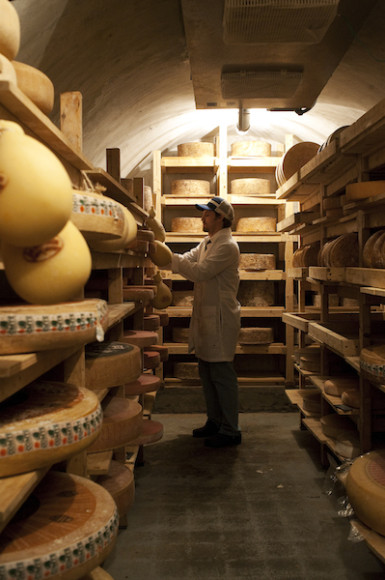 It didn’t hurt that, at the same time, the city’s foodies were discovering themselves. In Greenwich Village, Mario Batali had Po around the corner; David Page was at Home, and all were luring Manhattanites looking for more intense food, more intense flavors. Kaufelt found he was good at getting people to try those, too: “Discovering new cheeses was and is a turn-on for me,” he says, “and introducing them to my customers even more so.” He loved the action of the sale: “You’re moving, you’re schlepping, you’re slicing, you’re schmoozing, you’re interacting with people.” He even came to terms with being called Murray, a mistake that made him cringe at first. “Later, I accepted it,” says Kaufelt, “and would say I was really Murray the third—Murray, Louie, me.”
It didn’t hurt that, at the same time, the city’s foodies were discovering themselves. In Greenwich Village, Mario Batali had Po around the corner; David Page was at Home, and all were luring Manhattanites looking for more intense food, more intense flavors. Kaufelt found he was good at getting people to try those, too: “Discovering new cheeses was and is a turn-on for me,” he says, “and introducing them to my customers even more so.” He loved the action of the sale: “You’re moving, you’re schlepping, you’re slicing, you’re schmoozing, you’re interacting with people.” He even came to terms with being called Murray, a mistake that made him cringe at first. “Later, I accepted it,” says Kaufelt, “and would say I was really Murray the third—Murray, Louie, me.”
Within a few years, Murray the Third wasn’t just schmoozing behind his tiny counter, but traveling to Europe on regular tasting trips and buying jaunts, booking deals to bring cheeses that were rarely seen in the country, often with Tamasin Day Lewis, the British television chef—and sister of actor Daniel Day Lewis— whom he was dating at the time. (His current wife is the author, activist and entrepreneur Nina Planck, a food celebrity in her own right who owns a network of London farmers markets, directed the New York Greenmarkets for six months and wrote two books on traditional foodways, one called Real Food. The mother of his three small children, she’s also two decades his junior.)
A mere five years after Kaufelt bought the place, as he was planning to expand to the current location across the street, a New Yorker article declared him not just a top cheesemonger but an important tastemaker. “In the past few years,” wrote Cynthia Zarin, “the cheese landscape in New York—what kind of cheese you can buy, who makes it, who’s eating it and where—has changed dramatically; it’s like the moment when black-and-white TV turned into full-spectrum color, and in that world Kaufelt is key.”
That kind of dramatic change can also be found in the contributions of his alumni. His counters have served as not just a training ground for mongering—think Anne Saxelby of Saxelby Cheesemongers, and managers at Lucy’s Whey and Artisanal, to name but a few—but a launchpad for many of the most important businesses in the current good food movement. Murray’s men and women now work across the river running Bklyn Larder and Stinky Bklyn. They serve as chefs on The Martha Stewart Show, work as butchers (a former counterman, Tom Mylan, went on to launch Williamsburg’s now famous Meat Hook) and make beer in Long Island at Barrier Brewery. Zoe Brickley, Murray’s first cave manager, now sends cheese down to her former colleagues from the Cellars at Jasper Hill in Vermont, one of the best cheesemaking operations in the country. “Everyone you talk to in the specialty food world has worked for Murray’s,” says pickle maker McClure. “It’s not a job at Murray’s,” he says, “it’s more like an apprenticeship.” Or maybe even a master’s in food studies, except your professors actually pay you, for a change: “Murray’s was the quirky space where we all went,” says Taylor Cocalis, who ran Murray’s education program before leaving to launch GoodFoodJobs.com in 2009, “because nobody else was approaching food in quite the same way. It wasn’t gourmet,” she adds, “it was approachable, real, rooted in tradition and had a story. It’s where you went to find personality, and to dig deep into the history and culture.”
Geeking out on the traditions behind taste is classic Kaufelt, and the approach he’s always instilled in his staff. Kaufelt might no longer be working the line with all the new wide-eyed foodies—now he’s on projects like a cheese externship to get Cornell students into his caves, or dreaming up Murray’s first line of branded products—but he’s the one who instilled the spirit of the place into everyone who does.
Kaufelt wouldn’t just show a first-time cheesemonger how to cut a wheel of English Lancashire, but instead tell her about how a stoic Ruth Kirkham rubs the drying cheese barrels with butter by hand. Or the exact color of the grass beneath her 40 Friesian cows. If you’ve ever read one of Murray’s far-out product descriptions—“beneath a soft, furry white rind, Camembert is slurpy, soothing, mushroomy perfection; tucked away in its neat wooden box, liquid ecstasy awaits”— note that until recently, Kaufelt wrote almost all of them. It wasn’t just “super intense training,” he says of building his staff, “it was more like indoctrination.”
Perhaps no story illustrates that as much as one from Patrick Lango, who isn’t an employee, but a cheesemaker. His spritzy White Cow Dairy drinks and lovely fruit- and maple-flavored yogurts are bottled in tiny glass jars and made on his family’s four-generation free-ranging dairy farm near Buffalo. In Manhattan, they are only available at Murray’s, thanks in part to Lango’s kinship with Kaufelt.
In an e-mailed missive Lango describes the first time he met the man in person, back in 2004 when the shop was still in the tiny storefront on the corner of Cornelia. Introducing the farmer to his staff, Kaufelt didn’t just describe the process and the product, but gave a dramatic interpretation of its poetic importance: “Kaufelt says: ‘OK, into the back,’” recalls Lango, “and the Murray’s kids immediately grab sweatshirts and jackets and everybody crowds into an already crowded walk-in cooler, cheeses and butters and bottles to the ceiling—it’s the only place big enough for a meeting of more than two or three. Kaufelt kicks off on a hyperbolic prelude about goodness and greatness, about lost art, and blindness and waking up in a sensory cavern, drunk with a memory of a food you’ve never tasted, that bang: Feels like family… “I am not wearing a sweater, I do not have a pen and notebook, like some of the Murray’s kids smooshed into the cooler. But, I am beginning to wish I were writing some of this down, because it sounds so good as I am realizing: Rob Kaufelt is talking about us, describing how we farm and what we do with grass and cows and milk and why that translates into (sensory) pleasure, to begin with.
“Kaufelt is completely and entirely over the top, but he is also correct. He keeps saying to the staff, ‘Pay attention, pay attention to this flavor, you may never see it again.’ … I was weeping: Here was this voice in a cooler, jumping up and down, so intensely and personally, (honestly) about proper milk made into proper food … but that’s Kaufelt, and that’s Murray’s—deeply possessed by discovering really good food (somewhere) and sharing it.”
No doubt others could recount similar quixotic scenes. But these days, when you can buy prepackaged tasting flights of cheese at JFK, Whole Foods on the Bowery has a cheese room and even gastropubs in Queens offer a locally sourced cheese course for dessert, it’s easy to forget that until recently, working a retail counter would never have been considered a real career, let alone a romantic one.
When Murray’s current vice president Liz Thorpe started trailing Kaufelt in 2002, after quitting the corporate desk job she hated, she recalls, her coworkers and family members just “thought it was really weird.” Thorpe—who quickly became Kaufelt’s assistant, the head of the wholesale department and eventually the author of The Cheese Chronicles, a book about buying, selling and finding great cheese—admits she didn’t even buy that much artisanal product before she started working at Murray’s, because there were so few stores around the city that were stocking much of it.
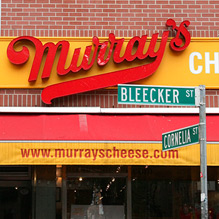 “For a long time, Murray’s was one of the only places where you could buy cheese,” says Will Guidara, the general manager of Eleven Madison Park. He’s talking, of course, about the cave-aged, washed rind, stinky-smelling stuff, which he’s been buying wholesale from Murray’s for years, rising through the ranks at Union Square Hospitality restaurants as Thorpe rose at Murray’s. When that New Yorker article appeared in 2004, Thorpe had just 75 restaurant clients— Guidara among them—and a cheese plate was still a tough sell. So were little-known cheeses: Back then, remembers Thorpe, “a chef would say, ‘I need something like fill-in-the-blank, can you go find it?’” Now instead of asking Murray’s to source some cheese they’d already tasted in Europe, they typically trust her to bring samples of what she likes, which these days is just as likely to be from Vermont or the Catskills as it is from Spain. (Like Kaufelt and a few other buyers at Murray’s, Thorpe still takes research trips from Seattle to Sicily several times a year to hit trade shows, browse local markets, walk pastures, and peruse caves.)
“For a long time, Murray’s was one of the only places where you could buy cheese,” says Will Guidara, the general manager of Eleven Madison Park. He’s talking, of course, about the cave-aged, washed rind, stinky-smelling stuff, which he’s been buying wholesale from Murray’s for years, rising through the ranks at Union Square Hospitality restaurants as Thorpe rose at Murray’s. When that New Yorker article appeared in 2004, Thorpe had just 75 restaurant clients— Guidara among them—and a cheese plate was still a tough sell. So were little-known cheeses: Back then, remembers Thorpe, “a chef would say, ‘I need something like fill-in-the-blank, can you go find it?’” Now instead of asking Murray’s to source some cheese they’d already tasted in Europe, they typically trust her to bring samples of what she likes, which these days is just as likely to be from Vermont or the Catskills as it is from Spain. (Like Kaufelt and a few other buyers at Murray’s, Thorpe still takes research trips from Seattle to Sicily several times a year to hit trade shows, browse local markets, walk pastures, and peruse caves.)
From Kaufelt’s perspective, the success of Murray’s—of good cheese in general—is a reflection of the city’s current obsession with eating, no matter the eater’s point-of-view. “All of the movements came together in the last seven or eight years,” says Kaufelt. “Everybody wants to know more about their food,” he says, and once they taste really good product, it’s hard not to want more: “Once they see Paree,” he jokes, “you can’t keep ’em down on the farm.”
Though these days, the opposite is actually more true: Customers who used to crave Camembert and chardonnay are today pairing Upland’s award-winning Pleasant Ridge Reserve from Dodgeville, Wisconsin, with a growler of local ale. Eleven Madison Park, for example, now serves only cheeses produced with 250 miles of Manhattan. But while Murray’s stocks more local cheeses than the Union Square Greenmarket, has single-handedly launched companies like White Cow and will almost always lend a hand to regional producers to help them better their products from the very beginning, Kaufelt won’t buy local for local’s sake. His outlook is mainly about taste. Sure, like his wife he’s a firm believer in food traditions being healthy for the body and world, but “mostly,” he says of his approach, “it’s ‘is it delicious or not?’”
Take Kinderhook Creek—a soft-ripened sheep’s milk cheese from Old Chatham Sheepherding Company upstate. After meeting with Old Chatham founder Tom Clark—like Kaufelt, he’s a Cornell alum—Murray’s asked if they could play around with aging the small wheels, to see if their affineur could improve the rind. Now Clark’s ultra-creamy rounds have gone on to win awards, some of them sent directly to competitions from Murray’s caves. They also share space with the C-Local, which starts life as a round of Kinderhook, but becomes its own funky, oozy creation after regular baths in Brooklyn Brewery Local Two Saison. (It’s also named after the nearby train line, says Thorpe, which gives off a similarly musty aroma.)
Murray’s has also launched a pilot project with Will Guidara, creating custom cheeses destined for Eleven Madison Park’s dessert menu. Throughout the winter, they offered three variations of Carleton Yoder’s Champlain Valley triple crème: One served as made; one layered with the restaurant’s pumpkin butter and a crown of pumpkin seeds; and one wrapped in apple tree leaves and soaked in applejack. If all that sounds a bit more elitist than the populist mission at Murray’s, it’s maybe balanced out by another of Kaufelt’s current projects, which is to expand Murray’s Melts, the gooey grilled cheeses— farm egg, Fontina, thick-cut bacon; double creme brie with caramelized onions, sauerkraut and cornichons—already offered on Bleecker Street. Kaufelt dreams of maybe adding some seating, a little space to stop and eat them right in the store, between the refrigerated cases of milks and butters and yogurts, the tubs of olives and pickles, the shelves of buckwheat honeys and sherry vinegars and Brooklyn-made bean-to-bar chocolates, the towers of crumbly cheddars and caramelly Goudas and creamy, salty blues. Have a sandwich, stick around and enjoy yourself, Kaufelt would likely tell you. After all, it’s just cheese.
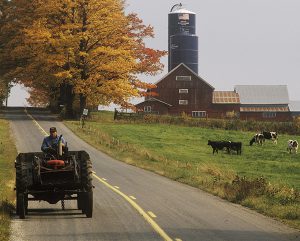 Crafting high-quality artisanal cheese is not complicated, but it’s also not easy. Basically, heat a lot of milk, add bacterial cultures and enzymes to thicken it into a curd, drain it, salt it, and let it ferment and age. Of course, to make cheese like this, you must first buy fresh milk or own a farm and stock it with cows or sheep or goats plus equipment, and spend endless strenuous hours carrying around heavy pails and obsessively cleaning equipment to make sure it’s sanitary. Do this day after day, until you have enough cheese to distribute, market and sell in a crowded marketplace. Then repeat the whole process.
Crafting high-quality artisanal cheese is not complicated, but it’s also not easy. Basically, heat a lot of milk, add bacterial cultures and enzymes to thicken it into a curd, drain it, salt it, and let it ferment and age. Of course, to make cheese like this, you must first buy fresh milk or own a farm and stock it with cows or sheep or goats plus equipment, and spend endless strenuous hours carrying around heavy pails and obsessively cleaning equipment to make sure it’s sanitary. Do this day after day, until you have enough cheese to distribute, market and sell in a crowded marketplace. Then repeat the whole process. A sense of where you are
A sense of where you are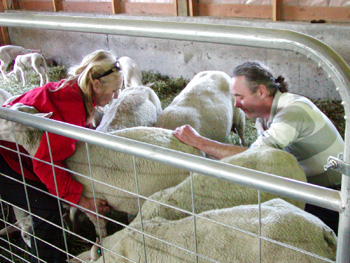 At
At 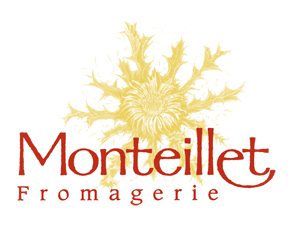
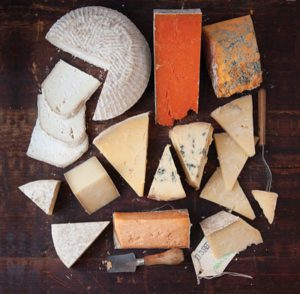






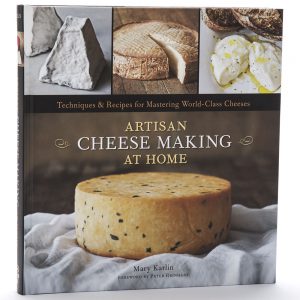
 From
From